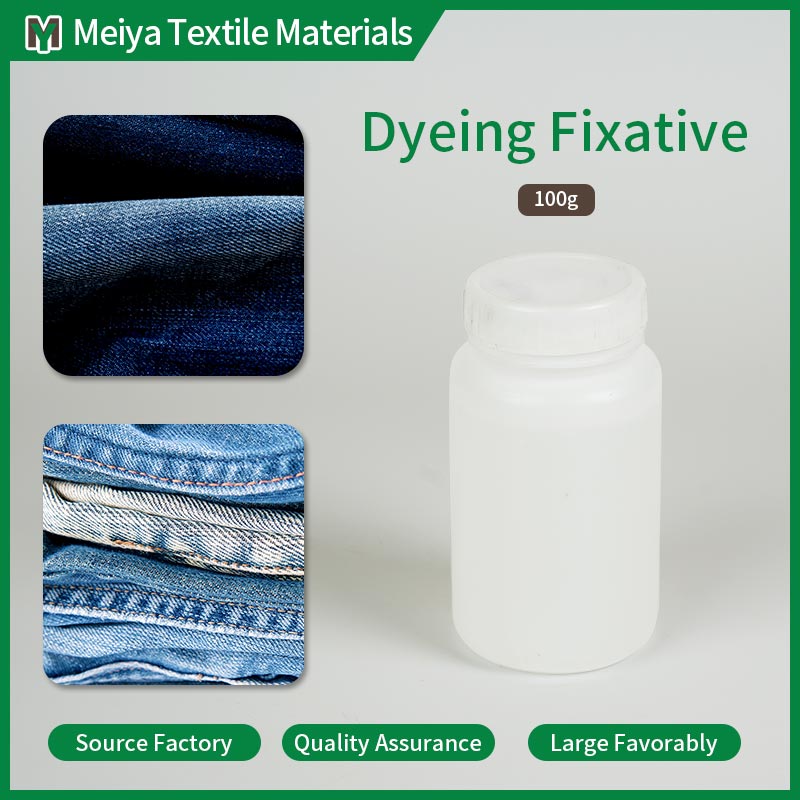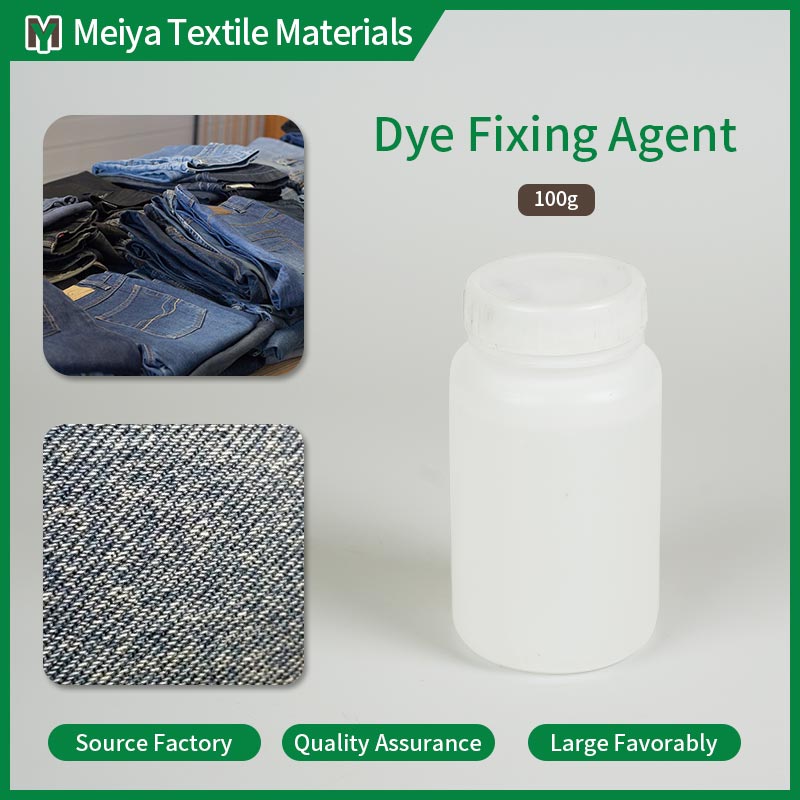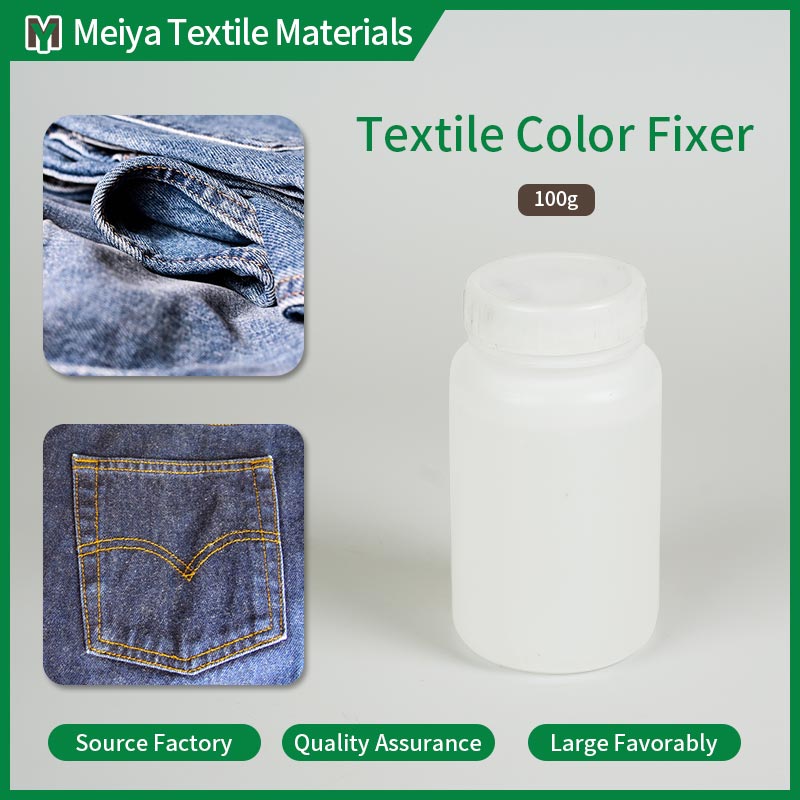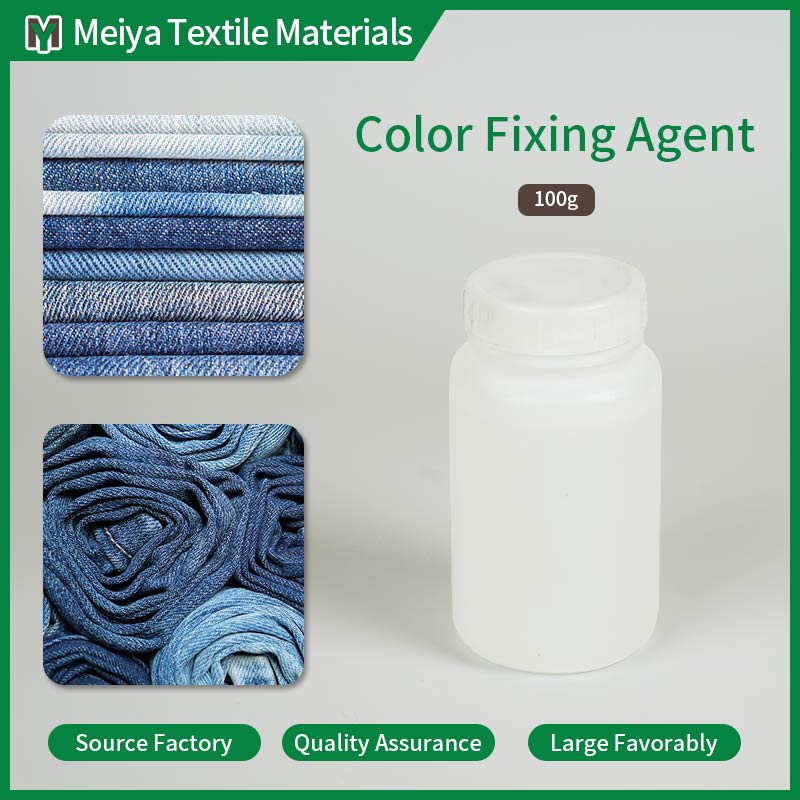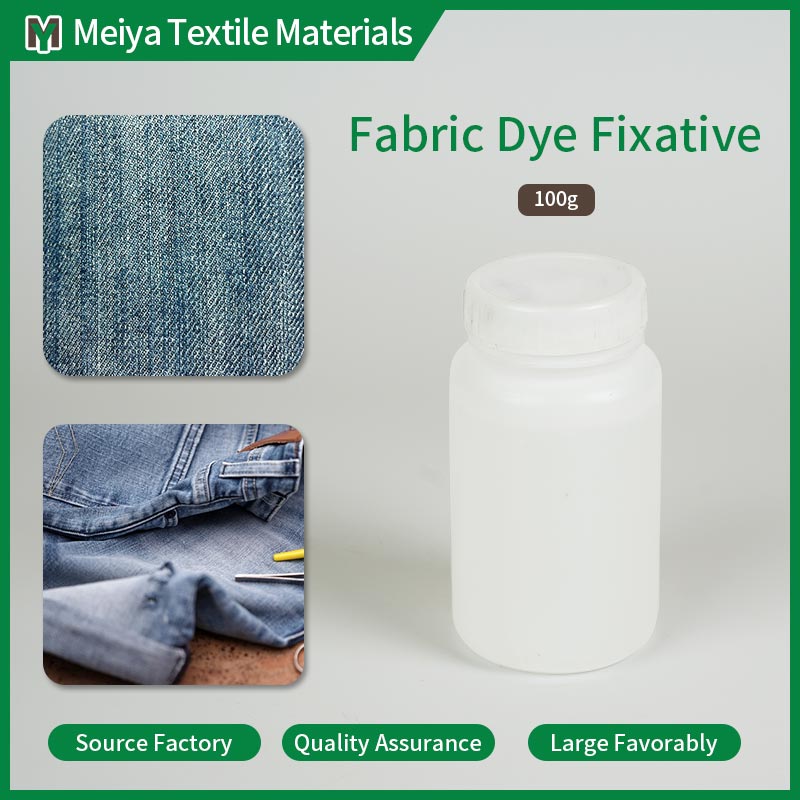Fabric Dye Fixative
Please click the button below to contact us.
Introduction:Fabric Dye Fixative is a professional chemical agent used to improve the dye fastness of fabrics. It is packaged in white plastic bottles, each with a capacity of 100g.
Product Description
Fabric Dye Fixative is a professional chemical agent used to improve the dye fastness of fabrics. It is packaged in white plastic bottles, each with a capacity of 100g. In the process of fabric dyeing, the combination of dye and fabric fibers is often not strong enough, which makes the fabric very prone to fading and discoloration during subsequent use, washing, and exposure to various environmental conditions. The fabric dye fixative is like a "color guardian". It can undergo complex chemical reactions with dyes and fibers or form a stable physical combination, thereby significantly enhancing the adhesion of dyes to fibers, making the color of the fabric more durable and brighter, giving textiles a better appearance and longer service life.
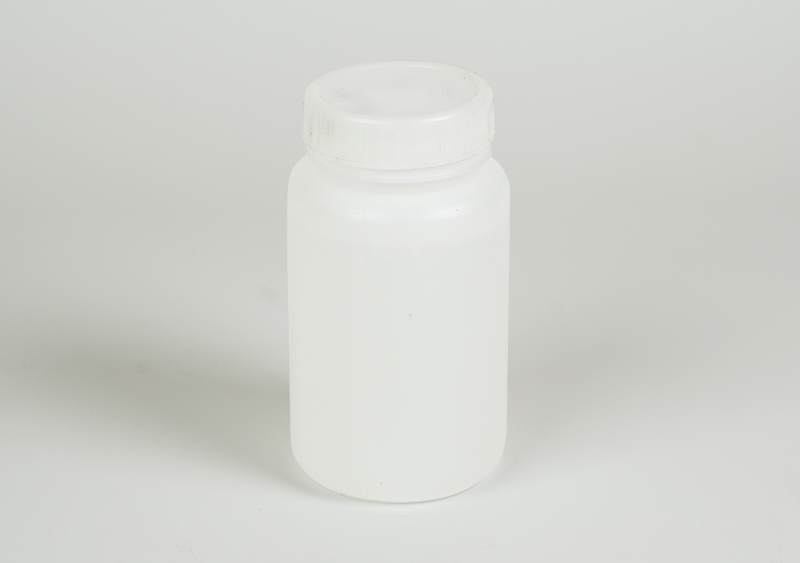
Fabric Dye Fixative Features:
Significantly improve color fastness: The Fabric Dye Fixative performs well in improving fabric color fastness. After use, the fabric's soap color fastness can be improved by 1-2 levels, and the rubbing color fastness can also be improved by 0.5-1.5 levels. Taking the standard test as an example, after washing in a 40°C soap solution for 30 minutes, the color change level of the untreated fabric is only 2-3 levels, while it can reach 3-4 levels after treatment with a fixing agent. This is because the fixing agent forms a tight protective film on the fiber surface, which firmly locks the dye and effectively prevents it from falling off during the washing process.
Wide applicability: Its application range is extremely wide, covering fabrics of various fiber materials, including natural fibers such as cotton, linen, silk, and wool, as well as synthetic fibers. It shows good fixing effects for various types of dyes such as reactive dyes, direct dyes, and acid dyes. In experiments with different fiber and dye combinations, whether it is dyeing cotton fabrics with reactive dyes or dyeing wool fabrics with acid dyes, the fixing agent can significantly improve color fastness, providing great convenience and flexibility for textile dyeing processes.
Good environmental performance: The color fixer strictly complies with environmental standards and does not contain harmful heavy metals and formaldehyde and other substances that are harmful to the human body and the environment. It has good biodegradability and can be decomposed by microorganisms quickly after discharge, causing less pollution to the environment. After professional testing, its ecological indicators meet the relevant environmental protection requirements, such as the volatile organic compound (VOC) content is far below the prescribed limit, and it can be safely used for dyeing and processing of various types of fabrics, meeting the high environmental protection requirements of the modern textile industry.
Strong acid and alkali resistance: Under different acid and alkali environments (pH 3 - 11), the color fixer can maintain a stable color fixation effect. In acid dyeing processes, such as acid dyeing of silk, it can resist the influence of acidic environment on the color fixation effect; in alkaline dyeing processes, such as reactive dyeing of cotton fabrics, it can also play an excellent color fixation role. This acid and alkali resistance makes it applicable to a variety of complex dyeing processes, and it will not lose its color fixation ability due to changes in acid and alkali conditions.
Does not affect the feel of the fabric: After using the color fixer, the feel of the fabric remains basically unchanged, and the fabric will not become stiff or rough. Through the hand feel test of various fabrics and the use of professional hand feel evaluation methods, it was found that the softness of the fabric changed very little before and after treatment. This is because it will not destroy the original structure of the fabric while enhancing the combination of dye and fiber, ensuring the comfort and original style of the fabric, and meeting the strict requirements of consumers for the hand feel of textiles.
Rapid color fixation: Under normal temperature conditions, the color fixation reaction can be basically completed within 30-60 minutes, greatly shortening the dyeing process time. Compared with traditional color fixers that require long-term high-temperature treatment, this color fixer improves production efficiency and reduces energy consumption. In industrial production, this means that the operating time and energy input of heating equipment can be reduced, production costs can be reduced, and the economic benefits of the enterprise can be improved.
High stability: The color fixer has good storage stability. When sealed and stored at room temperature, its performance remains basically unchanged within 1-2 years. It is not easy to precipitate, stratify, etc., which ensures the stability of product quality. Even during long-term storage, its chemical composition and physical properties can remain relatively stable, ensuring that the expected color fixation effect can be achieved every time it is used.
Good compatibility: It has good compatibility with other textile auxiliaries such as softeners, antistatic agents, etc., and can be used with these auxiliaries at the same time without adverse reactions. In the dyeing process, it is often necessary to use multiple auxiliaries at the same time to achieve different effects. The good compatibility of this fixing agent facilitates the comprehensive treatment of the dyeing process, reduces the process steps and costs, and improves production efficiency.
Where can we use Fabric Dye Fixative?
Garment dyeing and processing: In the garment production process, Fabric Dye Fixative plays a key role in both garment dyeing and fabric dyeing stages. For various styles of clothing, such as fashionable T-shirts, elegant shirts, classic jeans, etc., the use of this fixing agent can improve the color fastness of clothing. In garment dyeing, it can ensure that the color of the clothing is uniform and bright after dyeing, and does not fade during subsequent wearing and washing. For example, some personalized customized clothing, by using this fixing agent, can ensure that the clothing still maintains a unique color after multiple washings, meeting consumers' demand for clothing quality and personalization. In the fabric dyeing stage, it provides high-quality dyed fabrics for subsequent clothing production, improving the quality and market competitiveness of the entire clothing product.
Home textile product dyeing: Home textile products such as sheets, quilt covers, curtains, etc. need to have good color fastness to ensure the beauty after long-term use. This fixing agent can be used in the dyeing process of home textile products to ensure that the product does not fade during frequent washing and daily use. People often wash bed sheets and quilt covers. After using a color fixer, the color remains bright even after multiple washes, adding warmth and beauty to the home environment. Curtains are easily faded by ultraviolet rays when exposed to sunlight for a long time. The color fixer can effectively resist the influence of light on color and keep the color of curtains stable. At the same time, the quality of home textile products directly affects people's quality of life. The use of a color fixer improves the quality of the product and meets consumers' pursuit of high-quality home life.
Textile repair and renovation: For some faded or unevenly dyed textiles, fabric dye color fixers can be used for repair and renovation. In the restoration of some old textiles, many fabrics with historical value have faded due to the passage of time and the influence of preservation conditions. By re-dyeing and using a color fixer, these textiles can be restored to their original bright colors, extending their service life and protecting cultural heritage. In the field of second-hand textile renovation, for some clothes or fabrics with good color but not bright enough, the use of a color fixer for renovation can make them revitalized, meet the market demand for the reuse of second-hand goods, and also save resources.
Handicraft fabric dyeing: When making fabric crafts, such as embroidery and woven crafts, the color brightness and fastness are required to be high. The color fixer can help the crafts maintain the color durability during the preservation and display process. Embroidery works usually have exquisite patterns and rich colors. The use of color fixers can ensure that these colors do not fade for a long time, so that the artistic value of the works can be better reflected. Woven crafts such as blankets and tapestries can maintain bright colors in daily use and display after color fixation treatment, becoming artworks with collection and decorative value. At the same time, for some handmade fabric crafts, the use of color fixers can also improve the quality and market competitiveness of the products.
Industrial fabric dyeing: Some fabrics in the industrial field, such as filter cloth, conveyor belts, tents, etc., need to have good washability and color fastness. Fabric dye fixers can improve the color stability of these industrial fabrics, making their colors less likely to fade in harsh working environments and frequent washing processes. The filter cloth will be exposed to various chemicals and impurities during the filtering process. The use of a color fixer can ensure that its color remains stable after long-term use, while ensuring that the filtering effect is not affected. The conveyor belt is constantly running and rubbing in industrial production. The color fixer can prevent the color from falling off due to friction and maintain the appearance and performance of the conveyor belt. Tents are used outdoors and will be affected by natural environments such as wind, rain, sun and rain. The use of a color fixer can make its color lasting and bright, and improve the service life and practicality of the tent.
Dyeing of automotive interior fabrics: The fabric parts of the automotive interior, such as seat fabrics, ceiling fabrics, etc., need to withstand friction, light and cleaning in daily use. The use of this color fixer can improve the color fastness of automotive interior fabrics, keep their colors bright during long-term use and cleaning, and enhance the beauty and comfort of the interior of the car. Car seat fabrics are often in contact with the human body and will be affected by friction and sweat. The color fixer can prevent the color from fading due to these factors. The ceiling fabric is exposed to the lights and sunlight in the car for a long time. The use of a color fixer can resist the damage to the color caused by light. At the same time, it meets the high-quality requirements of the automotive industry for interior materials and improves the overall quality and market competitiveness of automobiles.
Stage costumes and props fabric dyeing: Stage costumes and props fabrics usually need bright colors and long-lasting effects to adapt to frequent performances and stage lighting. Fabric dye fixatives can meet this demand, ensuring that stage costumes and props remain bright in color after multiple performances, adding visual effects to stage performances. In some large-scale musicals, the actors' costumes need to be washed and replaced many times. The use of fixatives can ensure the stability of the color of the costumes, so that the actors always present the best visual effects on the stage. For stage prop fabrics, such as curtains, props and scenery, the fixative can keep the color bright after lighting and long-term use, enhancing the appeal and artistic effect of stage performances.
School and group clothing dyeing: School uniforms, group activity clothing, etc. usually need to be dyed in batches, and require consistent colors and high fastness. The fixative can ensure that the color of each garment can achieve the ideal effect during large-scale dyeing, and will not fade during subsequent use and washing. School uniforms represent the image of the school. Uniform colors and good color fastness can enhance the overall image of the school. For group activity clothing such as sports team uniforms and club clothing, the use of color fixers can ensure that the colors remain uniform after multiple activities and washings, enhancing the cohesion and image of the team. At the same time, it facilitates the management and maintenance of clothing and reduces the cost of changing clothing.
Fabric dyeing of pet products: Pet products such as pet nests and pet clothes need to be washed frequently and may be chewed and rubbed by pets. The use of fabric dye color fixers can improve the color fastness of these products, so that they will not fade during multiple washings and pet use, and keep the products beautiful and hygienic. The pet nest is a place for pets to rest daily. It is easy to be stained and odorous, and needs to be washed frequently. The color fixer can ensure that the color of the pet nest remains bright after washing. Pet clothes will be rubbed and pulled during pet activities. The use of color fixers can prevent the color from falling off, while ensuring the safety of pet products and not affecting the health of pets due to fading.
Experimental and research purposes: In the field of textile scientific research and experimental teaching, fabric dye fixing agent can be used to study the dyeing properties of different fibers and dyes, as well as to explore new dyeing processes and methods. Researchers can use this fixing agent to observe and analyze its effect on color fastness, providing data support and theoretical basis for the innovation and development of textile technology. In the experimental teaching of textile majors in colleges and universities and scientific research institutions, students can use this fixing agent for practical operations and gain a deep understanding of dyeing processes and fixing principles. In textile scientific research, researchers can use it to conduct comparative experiments, explore new ways to improve dyeing effects and color fastness, and promote technological progress in the textile industry.
Fabric Dye Fixative Maintenance:
Sealed storage: Unused fabric dye fixing agents should be strictly sealed for storage. Moisture and impurities in the air may enter the bottle and react chemically with the fixing agent, thus affecting its performance. When storing, make sure the bottle cap is tightened and store it in a dry, cool, ventilated place away from direct sunlight. Generally speaking, sealed storage in a dry environment below 25°C can effectively extend its shelf life. If improperly stored, the fixing agent may fail prematurely, resulting in failure to achieve the expected fixing effect in subsequent use.
Avoid mixed storage: It is very necessary to store the fixing agent separately from other chemicals. In particular, substances such as strong acids, strong alkalis, and oxidants may react violently with the fixing agent, causing the fixing agent to deteriorate or fail. In the warehouse, a special storage area should be set up and clearly marked to prevent misplacement and misuse. At the same time, the separate storage of chemicals of different properties is also conducive to safety management and reduces the risk of safety accidents such as fire and explosion.
Regular inspection: Regular inspection of the storage status of the fixing agent is an important part of ensuring its quality. Carefully observe whether there are precipitation, stratification, discoloration and other phenomena. If any abnormality is found, stop using it immediately and contact the supplier or professional personnel for testing and treatment. It is recommended to conduct a comprehensive inspection every 3-6 months, and professional testing tools and methods should be used during the inspection. Timely detection of problems can avoid the use of deteriorated color fixers, ensure production quality, and reduce production losses caused by color fixer quality problems.
Prevent freezing: In low temperature environments, color fixers may freeze, which will affect their use effect. If the storage environment temperature may be below 0℃, effective warming measures should be taken, such as wrapping with insulation materials or storing in a warm room. Once the color fixer is frozen, it should be thawed naturally at room temperature and fully stirred before use. However, it should be noted that the performance of the thawed color fixer may decline, and a small sample test is required to ensure that it still meets production requirements. If the test results are not ideal, the use of the color fixer of this batch should be stopped.
Correct use: When taking the color fixer, clean and dry tools should be used to avoid bringing in moisture and impurities. Because moisture and impurities may affect the purity and performance of the color fixing agent, and thus affect its color fixing effect. Seal the bottle mouth in time after use to prevent volatilization and contamination. During operation, strictly follow safety regulations, wear protective equipment such as gloves and goggles, and avoid contact between the color fixing agent and the skin and eyes. If accidentally contacted, rinse immediately with plenty of clean water and seek medical attention in time.
Control storage temperature: Try to store the color fixing agent in an environment with relatively stable temperature to avoid excessive temperature fluctuations. The storage temperature should be controlled between 10-30℃. Too high temperature may cause the effective ingredients of the color fixing agent to decompose and reduce its color fixing performance; too low temperature may cause freezing and performance changes. A thermometer can be used to monitor the storage environment in real time, and appropriate temperature control measures can be taken, such as installing air conditioners or heating equipment to ensure that the temperature is within an appropriate range.
Avoid vibration: Avoid severe vibration during transportation and storage. Although slight vibration may not have a significant effect on the performance of the color fixing agent, severe vibration may cause the internal structure of the color fixing agent to be destroyed, causing problems such as stratification or precipitation, affecting its uniformity and use effect. When handling, be gentle and use appropriate handling tools, such as a trolley or forklift, and ensure that the handling process is smooth and orderly.
Record and save information: Establishing a storage file for color fixers is a very important management task. Recording its production date, storage date, storage location, inspection status and other information can facilitate the management and tracking of the use of color fixers. Through these records, expired or deteriorated color fixers can be handled in time to avoid misuse. At the same time, it is also helpful to trace and analyze problems when they arise, find out the causes of the problems, and take corresponding improvement measures. Electronic management systems or paper archives can be used for recording to ensure the accuracy and completeness of information.
Train operators: Professional training for operators who use and keep color fixers is essential. The training content should include the characteristics of color fixers, storage methods and safety precautions. Operators should be familiar with the use specifications and emergency treatment measures of color fixers to ensure that they can use and keep color fixers correctly during operation. Through training, the professional quality and safety awareness of operators can be improved to avoid quality problems or safety accidents caused by improper operation. Training can be conducted regularly, such as once every six months, to update the knowledge and skills of operators.
Waste disposal: Expired or deteriorated fabric dye fixing agents should be disposed of in accordance with relevant environmental protection regulations. They cannot be dumped or discharged at will to avoid pollution to the environment. You can contact a professional waste disposal company to dispose of the fixing agent harmlessly to ensure compliance with environmental protection requirements. During the waste disposal process, records should be kept for supervision and traceability. At the same time, enterprises should actively fulfill their social responsibilities, promote green production and environmental protection treatment, and contribute to protecting the environment.
Fabric Dye Fixative FAQs:
1. What are the advantages of using your dye fixative?
The main advantage is durability of colors on washing since our Fabric Dye Fixative increases the strength of dye bonds with textile fibers. The customers will therefore enjoy every item of denim product because it retains its quality after end users have washed them several times.
2. Is your dye fixative suitable for all types of denim?
Certainly! Our Fabric Dye Fixative always delivers desired results when applied on raw, washed, and stretch denim as it is made to suit all the different kinds of dye, dealing with fabric variations.
3. What are the environmental benefits of using your dye fixative?
First of all, our Fabric Dye Fixative has been formulated with the environment in focus. It reduces the amount of excess dye that gets washed off out during the washing operations thereby contributing to water pollution. Also, it facilitates manufacturers to reduce the amount of dye in order to support green production.
4. How can I determine the optimal dosage for my production?
Before any records are made, we advise that preliminary tests be done so as to determine the optimum dose of our dye fixative for the particular piece of denim fabric and the dyeing technique. For efficient usage our technical support staff are also able to help with this.
5. Which quality standards do you observe?
We strictly comply with quality control and all industry standards applicable to ensure that our Fabric Dye Fixative is effective. Our products have passed a number of safety and efficacy tests and therefore manufacturers have dependable options for their dyeing operations.

